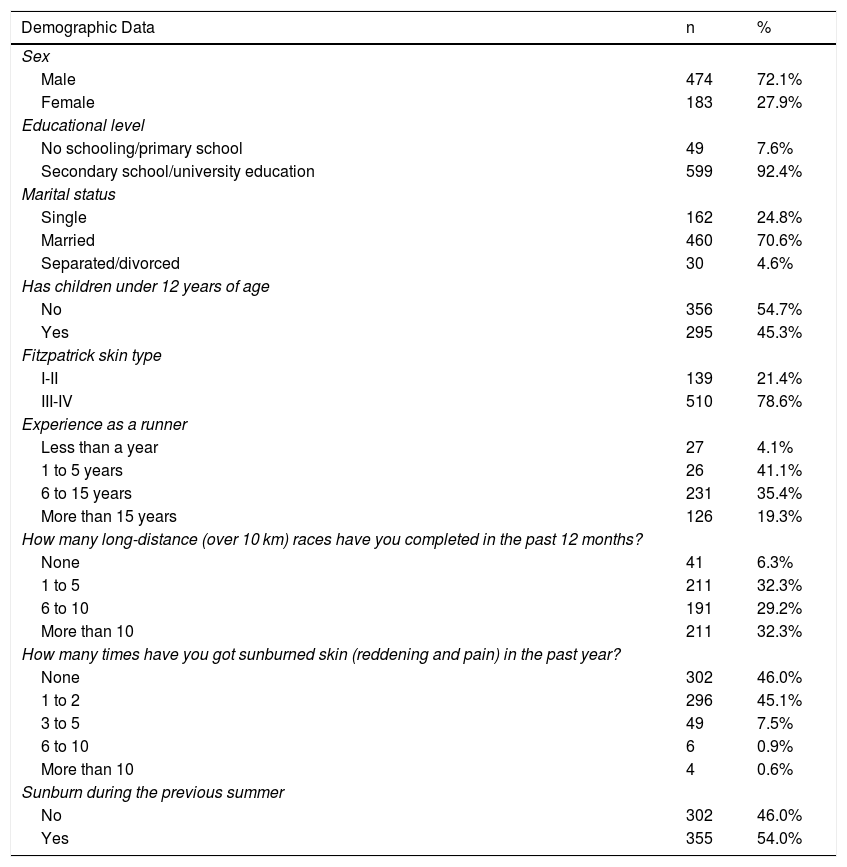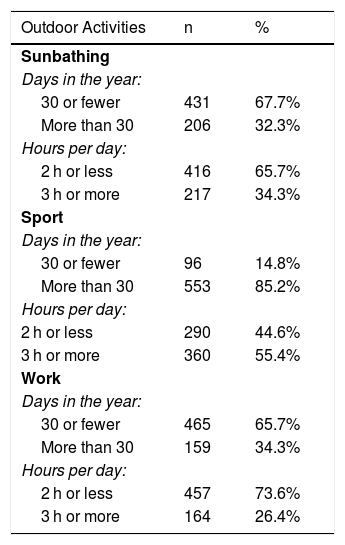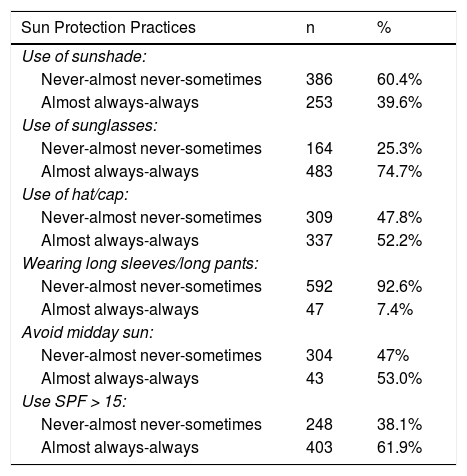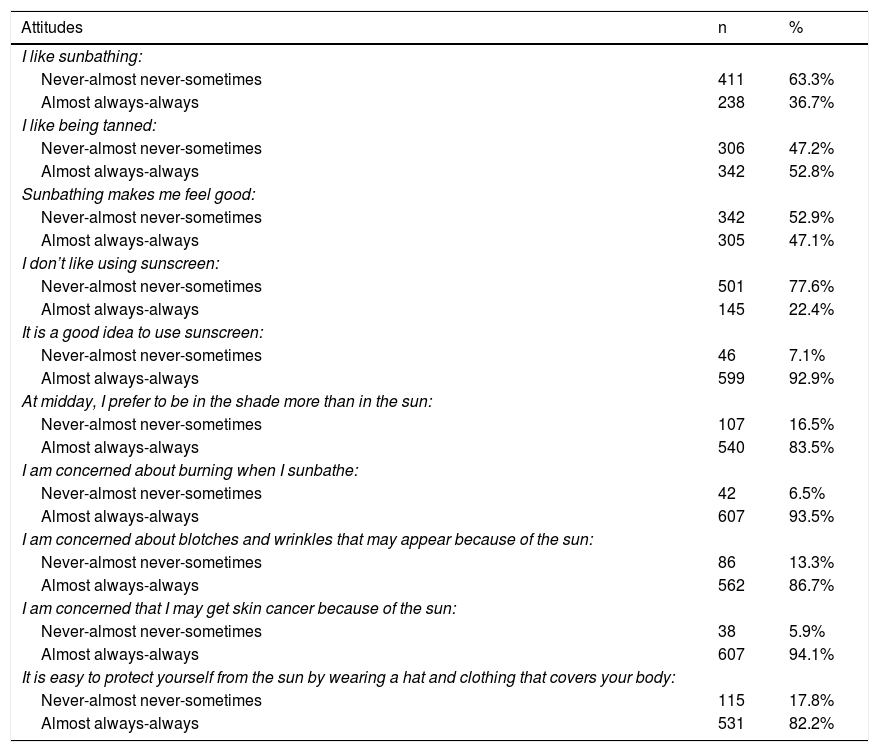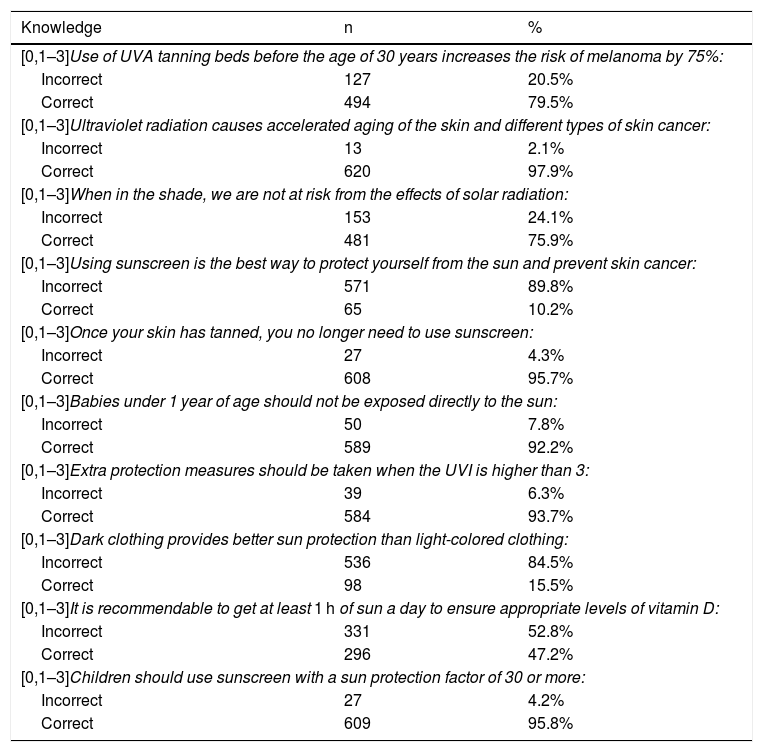The incidence of skin cancer in our society is growing at an alarming rate due to overexposure to solar UV radiation in recreational and occupational settings. The aim of this study was to evaluate sun exposure and protection attitudes, behaviors, and knowledge among mountain ultramarathon runners and to assess risk factors for sunburn in this population.
Material and methodsCross-sectional survey of runners who participated in the Gran Trail Aneto-Posets race in Aragon, Spain. Using a validated questionnaire, we collected data on sociodemographic characteristics, running experience, sunburn in the previous summer, and sun exposure and protection behaviors. We calculated descriptive statistics and performed bivariate and multivariate analyses of associations using history of sunburn as the primary outcome. Statistical significance was set at a P level of less than .05.
ResultsWe surveyed 657 runners (72.1% men) with a mean age of 39.71 years; 45.1% reported sunburn in the past year. The most common protective measures used were sunglasses (74.7%), sunscreen (sun protection factor ≥ 15) (61.9%), a hat (52.2%), and other protective clothing (7.4%). Risk factors for sunburn were younger age, low Fitzpatrick skin type (I and II), running for 3 or more hours a day, and staying in the shade as a protective measure. By contrast, protective factors were use of sunscreen and seeking shade rather than sun at midday (P < .001).
ConclusionsSunburn is common among long-distance mountain runners, despite what appears to be adequate sun protection knowledge and behaviors. Targeted strategies are needed to improve sun protection behaviors among mountain runners.
El cáncer cutáneo está aumentando su incidencia de forma alarmante en nuestra sociedad debido a la sobreexposición a la radiación ultravioleta solar, ya sea por motivos laborales u ocio.
El objetivo del presente estudio es valorar los conocimientos, actitudes y hábitos sobre exposición solar y fotoprotección en corredores participantes en una ultramaratón de montaña así como estimar los factores de riesgo para sufrir quemadura solar.
Material y métodosEstudio trasversal, prospectivo descriptivo, en los participantes de la “Gran Trail Aneto-Posets”. Se evaluaron las características sociodemográficas, experiencia como corredor, historia de quemadura solar en el verano previo y hábitos y prácticas de exposición solar mediante una encuesta validada. Se realizó análisis descriptivo, bivariado y multivariante tomando como variable principal de resultado la presencia de quemadura solar, estableciendo nivel de significación en p < 0,05.
ResultadosSe incluyeron 657 corredores, 72,1% hombres, con una media de edad 39,71 años. El 45,1% de los encuestados reconocían haberse quemado en el último año. Las gafas fue el método fotoprotector más utilizado (74,7%), seguido del fotoprotector (FPS > 15) (61,9%), el gorro/a (52,2%), y por último la ropa (7,4%). Mientras que tener menos edad, fototipo bajo (I y II), correr 3 o más horas al día y resguardarse a la sombra como medida de fotoprotección se comportaron como factores de riesgo para haber sufrido quemadura solar; las actitudes favorables al uso de cremas y a la búsqueda de la sombra al mediodía en vez de estar al sol, se comportaron como factores protectores (p < 0,001).
ConclusiónLa incidencia de quemaduras solares es alta entre los corredores de trails de largas distancia en montaña, pese a que sus conocimientos y hábitos parecen adecuados. Se necesita diseñar estrategias para mejorar los hábitos de fotoprotección adaptados a su práctica deportiva.
The incidence of skin cancer, especially melanoma, has been increasing in recent years, at a constant and alarming rate in Europe.1 In Australia, the country with the highest rates of skin cancer in the world, the rates of this disease are increasing and may continue to increase in the future owing to longer heatwaves with higher temperatures.2
Exposure to sunlight is the most important causal factor,3 and 2 sunlight-exposure patterns have been identified: occupational, more associated with chronic exposure to solar UV radiation (UVR); and recreational, more associated with sporadic intense exposure and a history of sunburn.4,5
One of the factors that increases overexposure to UVR is practising sport outdoors.6 These athletes spend long periods outdoors training and competing and, furthermore, the sweating caused by physical exertion may facilitate solar damage by producing a lensing effect of the UVR on the skin, thereby increasing the risk of sunburn and skin cancer.7 Training in the middle of the day, altitude with mountain runners, the lack of shade, and the type of sports clothing used in each training session are other factors that increase risk.8 Several studies have shown greater risk of developing skin cancer, principally melanoma, in marathon runners.9 Markers for risk of skin cancer have even been identified, such as the presence of lentigo and atypical nevus.10
It is estimated that up to 80% of cases of skin cancer could be prevented by reducing exposure to the sun by using protective means such as sunscreen, hats, sunglasses, and long-sleeved shirts, when activities are carried out outdoors on sunny days.11
Outdoor sports such as athletics are increasingly gaining adepts, from short races to the current trend of middle and long distance. Mountain or trail ultramarathons are a challenge for many runners, as they combine long distances with the difficulty accumulated climbs. In this type of race, exposure to solar radiation is increased by altitude. Moreover, these races mostly take place in the spring and summer months, when the ultraviolet index (UVI) reaches very high and extreme values.12 During the summer, in our latitudes, athletes can receive UVR doses equivalent to 22 minimal erythema doses (MED) for Fitzpatrick skin type II at sea level, which, with the added factor of altitude, may exceed 25 MED.13
The object of this study is to evaluate the knowledge, attitudes, and behaviors associated with exposure to solar radiation and sun protection in runners who take part in a mountain ultramarathon and to analyze the risk factors for suffering from sunburn.
Materials and MethodsParticipants and RaceA descriptive, prospective cross-sectional study of the participants in a mountain ultramarathon, the “Gran Trail Aneto-Posets” (GTTAP) race, held between July 22 and July 24, 2016. The GTTAP is a mountain race held in the Benasque Valley (Huesca, Spain), in a unique location between the two highest peaks of the Pyrenees, Aneto (3404 m) and Posets (3375 m). The GTTAP consists of five races with trials of between 9 and 108 km, with climbs of between 450 and 6700 m. The study population consists of experienced athletes with many hours of accumulated training and exposure to the sun.
Runners who took part in any of the 5 trials were recruited as volunteers to complete the questionnaire on paper or online; all the participants signed an informed consent document.
QuestionnaireWe examined sociodemographic characteristics, experience as a runner, skin color, eye color, Fitzpatrick skin type, and behavior regarding exposure to the sun (6 items), total sunburn (SB) in the past year, sun protection practices (6 items), attitudes (10 items), and knowledge (10 items) by means of a validated survey14 (the complete questionnaire is available as part of the supplementary material). We also asked about participants’ sports habits: number of years running, number of races over 10 km run in the past year, and maximum distance run in a training session or competition, in kilometers. The number of days and hours per day of exposure to the sun outdoors in the previous year were also counted in 3 categories: sunbathing, sport, and work outdoors.
After completing the questionnaire, all participants were provided with advice on primary prevention of skin cancer and an information leaflet.
Calculation of Ultraviolet Radiation Received During the RaceThe total dose of UVR received during the race was measured using a radiometer with an erythema response ultraviolet sensor and a function that allowed it to collect data at minute intervals for subsequent integration into total doses of radiation (Soluzderm UVer 2.0, Spain), located on the shoulder of one of the runners.
Statistical AnalysisA descriptive bivariate analysis was performed with the presence of SB taken as a segmentation variable and statistical significance of P < .05. A multivariate logistic regression analysis was also carried out including variables with statistical significance (P,.05) as independent variables or potential confounding variables (P<.01). Statistical analysis was performed using the SPSS statistical software package version 19.0 (IBM).
Ethics CommitteeThe study was approved by the research ethics committee of the autonomous region of Aragon (CEICA).
ResultsOf the 3200 registered runners who took part in the different trials, 657 completed the questionnaire and were analyzed, giving a participation rate of 20.53%. A total of 8 maximum UVI peaks occurred during the race, even though the day was cloudy. The UVR dose throughout the day with erythematous effect was 1575 J/m2, which, due to cloud cover, led to a total dose of 6.3 MED for Fitzpatrick type II.
A total of 72.1% (n = 474) were men and 27.9% (n = 183) were women, with a mean (SD) age of 39.71 (7.86) years. A total of 85.2% (n = 553) of the participants stated that they practice outdoor sports more than 30 days a year, 41.1% (n = 268) had been carrying out this activity for a mean of 5 years, and the mean (SD) maximum distance run was 45.60 (28.60) kilometers. Most of the runners identified their Fitzpatrick skin type as III-IV (78.6%, n = 510) and 45.1% (n = 296) acknowledged having suffered from sunburn in the previous year (Tables 1 and 2).
Dermographic Data, Experience as a Runner, and Sunburn.
| Demographic Data | n | % |
|---|---|---|
| Sex | ||
| Male | 474 | 72.1% |
| Female | 183 | 27.9% |
| Educational level | ||
| No schooling/primary school | 49 | 7.6% |
| Secondary school/university education | 599 | 92.4% |
| Marital status | ||
| Single | 162 | 24.8% |
| Married | 460 | 70.6% |
| Separated/divorced | 30 | 4.6% |
| Has children under 12 years of age | ||
| No | 356 | 54.7% |
| Yes | 295 | 45.3% |
| Fitzpatrick skin type | ||
| I-II | 139 | 21.4% |
| III-IV | 510 | 78.6% |
| Experience as a runner | ||
| Less than a year | 27 | 4.1% |
| 1 to 5 years | 26 | 41.1% |
| 6 to 15 years | 231 | 35.4% |
| More than 15 years | 126 | 19.3% |
| How many long-distance (over 10 km) races have you completed in the past 12 months? | ||
| None | 41 | 6.3% |
| 1 to 5 | 211 | 32.3% |
| 6 to 10 | 191 | 29.2% |
| More than 10 | 211 | 32.3% |
| How many times have you got sunburned skin (reddening and pain) in the past year? | ||
| None | 302 | 46.0% |
| 1 to 2 | 296 | 45.1% |
| 3 to 5 | 49 | 7.5% |
| 6 to 10 | 6 | 0.9% |
| More than 10 | 4 | 0.6% |
| Sunburn during the previous summer | ||
| No | 302 | 46.0% |
| Yes | 355 | 54.0% |
Solar Exposure Behavior. Outdoor Activities.
| Outdoor Activities | n | % |
|---|---|---|
| Sunbathing | ||
| Days in the year: | ||
| 30 or fewer | 431 | 67.7% |
| More than 30 | 206 | 32.3% |
| Hours per day: | ||
| 2 h or less | 416 | 65.7% |
| 3 h or more | 217 | 34.3% |
| Sport | ||
| Days in the year: | ||
| 30 or fewer | 96 | 14.8% |
| More than 30 | 553 | 85.2% |
| Hours per day: | ||
| 2 h or less | 290 | 44.6% |
| 3 h or more | 360 | 55.4% |
| Work | ||
| Days in the year: | ||
| 30 or fewer | 465 | 65.7% |
| More than 30 | 159 | 34.3% |
| Hours per day: | ||
| 2 h or less | 457 | 73.6% |
| 3 h or more | 164 | 26.4% |
Regarding sun protection measures, sunglasses were the most commonly used method (74.7%), followed by sunscreen (sun protection factor [SPF] > 15) (61.9%), cap (52.2%), and, finally, long-sleeved clothing or long pants (7.4%) (Table 1). Of those surveyed, 90% (n = 599) were concerned about skin cancer associated with the sun and stated that it was a good idea to use sunscreen (Tables 3–5).
Sun Protection Practices.
| Sun Protection Practices | n | % |
|---|---|---|
| Use of sunshade: | ||
| Never-almost never-sometimes | 386 | 60.4% |
| Almost always-always | 253 | 39.6% |
| Use of sunglasses: | ||
| Never-almost never-sometimes | 164 | 25.3% |
| Almost always-always | 483 | 74.7% |
| Use of hat/cap: | ||
| Never-almost never-sometimes | 309 | 47.8% |
| Almost always-always | 337 | 52.2% |
| Wearing long sleeves/long pants: | ||
| Never-almost never-sometimes | 592 | 92.6% |
| Almost always-always | 47 | 7.4% |
| Avoid midday sun: | ||
| Never-almost never-sometimes | 304 | 47% |
| Almost always-always | 43 | 53.0% |
| Use SPF > 15: | ||
| Never-almost never-sometimes | 248 | 38.1% |
| Almost always-always | 403 | 61.9% |
Abbreviation: SPF indicates Sun protection factor.
Attitudes Regarding Exposure to the Sun.
| Attitudes | n | % |
|---|---|---|
| I like sunbathing: | ||
| Never-almost never-sometimes | 411 | 63.3% |
| Almost always-always | 238 | 36.7% |
| I like being tanned: | ||
| Never-almost never-sometimes | 306 | 47.2% |
| Almost always-always | 342 | 52.8% |
| Sunbathing makes me feel good: | ||
| Never-almost never-sometimes | 342 | 52.9% |
| Almost always-always | 305 | 47.1% |
| I don’t like using sunscreen: | ||
| Never-almost never-sometimes | 501 | 77.6% |
| Almost always-always | 145 | 22.4% |
| It is a good idea to use sunscreen: | ||
| Never-almost never-sometimes | 46 | 7.1% |
| Almost always-always | 599 | 92.9% |
| At midday, I prefer to be in the shade more than in the sun: | ||
| Never-almost never-sometimes | 107 | 16.5% |
| Almost always-always | 540 | 83.5% |
| I am concerned about burning when I sunbathe: | ||
| Never-almost never-sometimes | 42 | 6.5% |
| Almost always-always | 607 | 93.5% |
| I am concerned about blotches and wrinkles that may appear because of the sun: | ||
| Never-almost never-sometimes | 86 | 13.3% |
| Almost always-always | 562 | 86.7% |
| I am concerned that I may get skin cancer because of the sun: | ||
| Never-almost never-sometimes | 38 | 5.9% |
| Almost always-always | 607 | 94.1% |
| It is easy to protect yourself from the sun by wearing a hat and clothing that covers your body: | ||
| Never-almost never-sometimes | 115 | 17.8% |
| Almost always-always | 531 | 82.2% |
Knowledge of Sun Protection.
| Knowledge | n | % |
|---|---|---|
| [0,1–3]Use of UVA tanning beds before the age of 30 years increases the risk of melanoma by 75%: | ||
| Incorrect | 127 | 20.5% |
| Correct | 494 | 79.5% |
| [0,1–3]Ultraviolet radiation causes accelerated aging of the skin and different types of skin cancer: | ||
| Incorrect | 13 | 2.1% |
| Correct | 620 | 97.9% |
| [0,1–3]When in the shade, we are not at risk from the effects of solar radiation: | ||
| Incorrect | 153 | 24.1% |
| Correct | 481 | 75.9% |
| [0,1–3]Using sunscreen is the best way to protect yourself from the sun and prevent skin cancer: | ||
| Incorrect | 571 | 89.8% |
| Correct | 65 | 10.2% |
| [0,1–3]Once your skin has tanned, you no longer need to use sunscreen: | ||
| Incorrect | 27 | 4.3% |
| Correct | 608 | 95.7% |
| [0,1–3]Babies under 1 year of age should not be exposed directly to the sun: | ||
| Incorrect | 50 | 7.8% |
| Correct | 589 | 92.2% |
| [0,1–3]Extra protection measures should be taken when the UVI is higher than 3: | ||
| Incorrect | 39 | 6.3% |
| Correct | 584 | 93.7% |
| [0,1–3]Dark clothing provides better sun protection than light-colored clothing: | ||
| Incorrect | 536 | 84.5% |
| Correct | 98 | 15.5% |
| [0,1–3]It is recommendable to get at least 1 h of sun a day to ensure appropriate levels of vitamin D: | ||
| Incorrect | 331 | 52.8% |
| Correct | 296 | 47.2% |
| [0,1–3]Children should use sunscreen with a sun protection factor of 30 or more: | ||
| Incorrect | 27 | 4.2% |
| Correct | 609 | 95.8% |
Abbreviations: UVA indicates ultraviolet-A; UVI, ultraviolet index.
In the multivariate analysis, the variables that were statistically associated with a greater risk of suffering sunburn in the previous year were the following: age (OR, 0.98; 95% CI, 0.97−0.99; P < .001); low Fitzpatrick skin type (I and II) (OR, 2.06; 95% CI, 1.35–3.14; P = .001); being single, separated or widowed compared to married (OR, 1.66; 95% CI, 1.45–2.41; P = .007); training for 3 hours or more per day in the previous year (OR, 1.01; 95% CI, 1.00–1.01; P = .048), and use of shade (“I use a sunshade/I keep to the shade“) as a practical sun protection method (OR, 1.42; 95% CI, 1.00–2.01, P = .048). Favorable attitudes toward using sunscreen (OR, 1.59; 95% CI, 1.05–2.41, P = .027), and seeking the shade at midday (“in the middle of the day, I prefer to be in the shade than in the sun”) (OR, 1.83; 95% CI, 1.14–2.96; P = .013) acted as protective factors against sunburn. Having suffered sunburn was independent of the number of years running, distances run, and the use of sunscreen with an SPF of 15 or over and the other behaviors (except use of shade) and knowledge of sun protection studied.
DiscussionThe results of our study show that mountain ultramarathon athletes present appropriate knowledge and attitudes for good sun protection. Almost 50% of those surveyed, however, had suffered sunburn in the previous year, despite being aware of the risk involved.
The first study of sun exposure carried out in runners was in 1999, at the Ironman World championship in Hawaii. Three athletes who wore water-resistant sunscreen with an FPS of over 25 in an 8-to-10 -h race accumulated more than 30 times the recommended limit for UV exposure of UV 2000 J/m2.15 Moreover, Serrano et al16 showed that the groups at greatest risk of exposure to the sun among outdoor athletes included cycling, with a UVR and personal erythematous potential of up to 3224 J/m2, tennis with 1065 J/m2, and 5-day marathon (762 J/m2). The number of MED received by the participants in our race was 6.3 for Fitzpatrick skin type II, far from the 20 that would have been obtained for that day if the skies had been completely clear. As well as the UVR received during the race, it is important to determine the number of hours spent running (at least 1 entire day), the climb (between 450 and 6700 m), altitude (up to 3375 m) and the presence of snow at higher altitudes, which may cause sun reflection, and even the low temperature, which may cause runners to underestimate UVR intensity. Added to all of the above is the sweating, which increases the risk of sunburn.7 A study carried out in similar conditions to ours, in the Pyrenees in the summer months, showed that, in athletes who practice outdoor sport, the daily mean standard erythemal dose (SED) was 8.1 with a dosimeter located on the shoulder, exceeding the maximum personal exposure of 5 SED.17 Another study, the aim of which was to determine the relationship between the prevalence of melanoma, altitude, and daily erythemal dose, found an increase in the prevalence of melanoma and he daily erythemal dose with higher altitudes, with the highest increase from 700 m.18 This indicates that mountain trail runners receive very high doses of UVR with the corresponding risk.
To date, in Spain, most studies in this field have been carried out using health surveys, which measure self-informed behavior with respect to exposure behavior and sun protection practices during outdoor sporting activities. The sports that have been studied include skating,19 golf,20 water sports,21 beach sports,22 and mountain sports.23
As in other articles published on runners, our study found that younger age (<45 years) and not being married was associated with a higher risk of sunburn.24 The association with age may be due to the fact that middle-aged and older people are more aware and more concerned for their health, possibly due to a personal history and/or contact with people who suffer from diseases such as skin cancer.25 With regard to the association with marital status, people generally take care of each other, alerting their partner to healthy behavior.26
Other studies have found that being a woman and having a low Fitzpatrick skin type was associated with greater awareness of skin cancer.27 In this study, however, no differences were found between the sexes, although a greater risk of sunburn was found among runners with a low Fitzpatrick skin type. A study that evaluated the sun exposure behavior based on age, gender, educational level, and Fitzpatrick skin type, found that lower Fitzpatrick skin types had a greater tendency toward sunburn and that women tend to sunbathe more, but use more sunscreen.28
As in other studies, sunglasses were the sun protection method most widely used by runners (74.7%).24 Furthermore, the use of shade as a method and practice of sun protection was associated with a greater risk of sunburn. This may be because shade protects from incident radiation but not reflected radiation, making it less effective than sunscreen in preventing sunburn.29 With regard to sunscreen, 61.9% stated that they almost always use this method (SPF > 15), a similar percentage to those obtained in marathon runners and those who practice beach sports,9,22 but higher than in other studies carried out in runners.24,27 Nevertheless, we did not find that use of sunscreen was a protective factor against sunburn, though the attitude toward the use of sunscreen was. This may be due either to improper use of sunscreen (too little or too few applications) or to the use of inadequate sunscreens (not sweat-resistant). This highlights the need to design specific sunscreens for athletes, with a high SPF, easy to apply, requiring few repeat applications, sweat-resistant, and that do not irritate the mucosa (eyes and lips). Moreover, they must be safe and efficient because, as we have shown, the people with the highest risk of sunburn are those who train outdoors for three or more hours a day.
The limitations of this study include the fact that the participation rate is not very high (20.53%), although it is higher than those obtained to date in other previous studies in runners, with participation rates of between 4% and 19.5%.24,27 Participation bias may also have been a factor, as the survey was carried out among those people most aware of skin cancer, which would have influenced better sun protection practices and greater awareness of that disease. Nevertheless, the fact that 50% of those surveyed admitted to having suffered sunburn in the previous year would seem to be a worrying finding.
In conclusion, the results of this study indicate that the incidence of sunburn is high among long-distance mountain trail runners, even though their knowledge and behavior appear to be appropriate. Factors such as age, Fitzpatrick skin type, and even marital status, as well as the number of hours spent training, help us to identify the most vulnerable groups. Strategies need to be designed to improve sun protection behavior adapted to each sport. It would appear that campaigns are needed on both primary and secondary prevention, promoting events at which individual safety, including sun protection, is a requirement in order to take part, with the use of caps, appropriate clothing, sunglasses, and specific sunscreens. It is also important to encourage these elite athletes to act as genuine influencers, thereby reinforcing potentially positive behaviors.
FundingThis study was funded by the research group recognized by the Regional Government of Aragón B18-17D.
Conflicts of InterestThe authors declare that they have no conflicts of interest.
The authors would like to thank the GTTAP organizers and medical team for their participation and help with this project.
Please cite this article as: García-Malinis AJ, Gracia-Cazaña T, Zazo M, Aguilera J, Rivas-Ruiz F, de Troya Martín M et al. Hábitos y conocimientos sobre fotoprotección y factores de riesgo para quemadura solar en corredores de maratones de montaña. Actas Dermosifiliogr. 2021;112:159–166.

